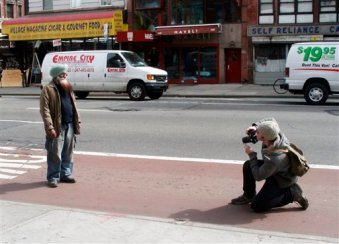
HONY’s Brandon Stanton is one of many individuals who uses crowdsourcing. Courtesy of Bebeto Matthews/AP
By Elizabeth Smislova
All great phenomena begin with someone who has an idea. But it is easy to have ideas — what is harder is transforming those ideas into something real. So how do you it? Why not consult the more than two billion Internet users worldwide?
Traditionally, crowdsourcing enables executives both to gain a greater understanding of their customers’ desires and to increase their supply of expertise. The term was coined by Wired magazine in 2005. Crowdsourcing consists of businesses reaching out to the public for assistance in completing tasks that they would usually perform. In return for helping a business, people receive credit or some sort of monetary reward. With a larger reserve of skilled people, efficiency and inventiveness increase with a reduced work expense. However, those contributors are not official employees, so they cannot be managed as such.
Jeff Howe, writer of “The Rise of Crowdsourcing” Wired magazine 14.06 in 2006, said “Crowdsourcing has virtually overnight generated huge buzz, enthusiasm, and fear. It’s the application of the open-source idea to any field outside of software, taking a function performed by people in an organization, such as reporting done by journalists, research and product development by scientists, or design of a t-shirt, for example, and in effect outsourcing it through an open-air broadcast on the Internet.”
This trend has expanded from achieving primarily corporate goals to helping people accomplish their personal ambitions through subcontracting, usually on the Internet. Benefits of crowdsourcing include the obtainment and adoption of an abundant workforce, leading to skyrocketing creative levels and completion of tasks at an unparalleled rate. A successful use of crowdsourcing requires a product that is somehow revolutionary, provides a resolution to a dilemma, and being desired in the market.
Social media plays a key role in conducting prosperous crowdsourcing. Twitter, Facebook, Pinterest, Google+ and numerous blogging platforms allow people to ask their followers for important opinions about product supply. Twitter also allows crowdsourcers to ask their consumers which product alternative they would rather buy. People therefore have a better picture of which products are more popular so can tailor inventory to fit demand. People also use straightforward vote contests and candidly ask their customers about their opinions. Incentive to vote can come from prizes—sometimes that is the commodity itself. Using hashtags and posting on Twitter about the contest throughout the day can draw more attention to a particular product.
Crowdsourcing is also used to fund projects and charitable acts. Websites like Kickstarter and Indiegogo enable users to complete people’s projects by giving financial backing in return for encouragements. Earlier last year in Georgia, teen Daniel Ashley Pierce secretly recorded himself being scolded by his parents when he told them he was gay. After posting the video on YouTube, he was sent $100,000 in crowdsourced contributions, with which Pierce opened a shelter for homeless LGBTQ adolescents. Pierce posted the video on a GoFundMe page on Aug. 27, 2014.
The site is free and allows users to establish their fundraising efforts, share it on social media (including Facebook, Twitter and email) and accept donations by check or bank transfer. The site also provides an outlet for posting updates and sending thank you notes to donators. People use GoFundMe for personal reasons like school tuition, sports teams, medical bills, volunteer trips, business ideas, special events, travel expenses or animals and pets.
Additionally, people can use crowdsourcing to seek human resources, with the only incentive being a simple act of kindness. For instance, Humans of New York (HONY) is a photoblog and book about people living in New York City; it includes pictures and interviews. This past Christmas, the site ran an experiment called HONY For The Holidays, conducted by site creator Brandon Stanton and his girlfriend. Stanton used social media and their blog to find people to house homeless New Yorkers during the holidays.
Journalists can obtain a great amount of information by reaching out to the public and increasing accuracy and efficiency. Weather forecasters and traffic reporters ask viewers and listeners to report events. Journalists and writers frequently seek the public to gain real insight and truth.
Howe said in his book Crowdsourcing in 2008, “The amount of knowledge and talent dispersed among the human race has always outstripped our capacity to harness it. Crowdsourcing corrects that—but in doing so, it also unleashes the forces of creative destruction.

Insightful article